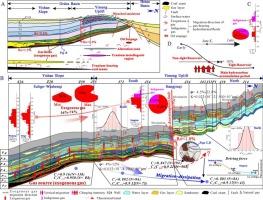鄂尔多斯盆地东北部天然气的长距离侧向运移、聚集与耗散
IF 7.2
1区 地球科学
Q1 GEOSCIENCES, MULTIDISCIPLINARY
引用次数: 0
摘要
鄂尔多斯盆地东北部发生了与后期转化有关的大面积天然气耗散。然而,鄂尔多斯盆地是否存在长距离的天然气运移、聚集和耗散仍然是一个科学争论的问题。以露头岩心资料为基础,结合方解石U-Pb定年、C-O-Sr同位素、镜质体反射率、流体包裹体、气体地球化学等资料,系统探讨了天然气长距离侧向运移耗散的特征和机制,揭示了独特的天然气成藏模式。研究表明,与天然气长距离运移耗散有关的白化碳酸盐胶结砂岩蚀变现象在东北盆地普遍存在。有机烃源岩与含烃热液密切相关,表明上古生界大规模高成熟煤成烃提供了有机碳源。分析表明,鄂尔多斯盆地天然气耗散始于早白垩世晚期,经历了多期大规模耗散。杭锦旗气田是盆地中央生灶天然气运散的优先区。杭锦旗气田本地烃源岩与天然气之间存在明显的成熟度矛盾。该气田天然气具有多源混合成藏的特点。杭锦旗及其南部邻气田(苏里格—乌胜旗)的油气成藏期与致密期重合或略早于致密期。区内约36% ~ 74%的天然气来自苏里格—乌胜旗气田,运移距离超过130 km,属于远源异位成藏模式。这种现象在陆相含油气盆地中极为罕见。大盆地广泛单斜带的长距离横向油气运移是沉积连续性、构造-储层通道效率、密封完整性和油气源充足等因素共同作用的结果,主要发生在海相含油气盆地。本文章由计算机程序翻译,如有差异,请以英文原文为准。

Long-distance lateral migration, accumulation and dissipation of natural gas in the northeastern Ordos Basin, China
Extensive natural gas dissipation linked to late-stage transformation occurred in the northeastern Ordos Basin. However, the existence of long-distance gas migration, accumulation, and dissipation in the Ordos Basin remains a subject of scientific contention. On the basis of outcrop-core data, combined with calcite U-Pb dating, C-O-Sr isotopes, vitrinite reflectance (Ro), fluid inclusions, and gas geochemistry, this research systematically investigated the characteristics and mechanisms of long-distance lateral migration and dissipation of natural gas and revealed a unique gas accumulation model. Research indicates that the alteration phenomena of bleached and carbonate-cemented sandstones (CCSs) associated with long-distance gas migration-dissipation are widespread in the northeastern basin. Organic-derived CCSs are closely related to hydrocarbon-bearing hydrothermal fluids, indicating that large-scale Upper Paleozoic high-maturity coal-derived hydrocarbons provide organic carbon sources. Analyses revealed that natural gas dissipation in the Ordos Basin initiated during the late Early Cretaceous, followed by multiple episodes of large-scale dissipation. The Hangjinqi gas field serves as the preferential zone for natural gas migration-dissipation from the central generation kitchen of the basin. A striking maturity contradiction exists between the local source rocks and the natural gas in the Hangjinqi gas field. The natural gas in this gas field is characterized by multi-source hybrid accumulation. The hydrocarbon accumulation period in Hangjinqi and its southern adjacent gas fields (Sulige-Wushenqi) coincided with or slightly preceded the reservoir densification period. Approximately 36 %–74 % of the natural gas within the field is derived from the Sulige-Wushenqi gas field, with migration distances exceeding 130 km, demonstrating a far-source allochthonous accumulation model. This phenomenon is exceedingly uncommon in continental petroliferous basins. The long-distance lateral hydrocarbon migration in extensive monoclinal zones of large basins results from the coupled interplay of sedimentary continuity, structural-reservoir conduit efficiency, seal integrity, and adequate hydrocarbon sourcing and is predominantly observed in marine petroliferous basins.
求助全文
通过发布文献求助,成功后即可免费获取论文全文。
去求助
来源期刊

Gondwana Research
地学-地球科学综合
CiteScore
12.90
自引率
6.60%
发文量
298
审稿时长
65 days
期刊介绍:
Gondwana Research (GR) is an International Journal aimed to promote high quality research publications on all topics related to solid Earth, particularly with reference to the origin and evolution of continents, continental assemblies and their resources. GR is an "all earth science" journal with no restrictions on geological time, terrane or theme and covers a wide spectrum of topics in geosciences such as geology, geomorphology, palaeontology, structure, petrology, geochemistry, stable isotopes, geochronology, economic geology, exploration geology, engineering geology, geophysics, and environmental geology among other themes, and provides an appropriate forum to integrate studies from different disciplines and different terrains. In addition to regular articles and thematic issues, the journal invites high profile state-of-the-art reviews on thrust area topics for its column, ''GR FOCUS''. Focus articles include short biographies and photographs of the authors. Short articles (within ten printed pages) for rapid publication reporting important discoveries or innovative models of global interest will be considered under the category ''GR LETTERS''.
 求助内容:
求助内容: 应助结果提醒方式:
应助结果提醒方式:


